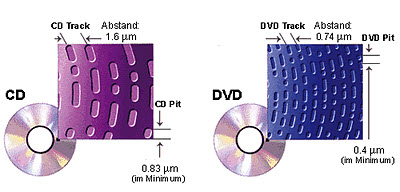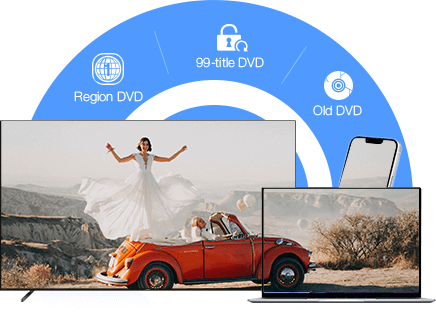CD vs DVD: The Differences between CD and DVD
 Donna Peng
Donna Peng
Updated on
CD and DVD are two different discs, as you may know. But they look really similar. What's exactly the difference between CD and DVD? You buy album music CDs from your favorite artists, but do you know they can also store data and video, like VCD. Things get more complicated with CD R/RW and DVD R/RW... If you want to explore more info about CD and DVD, this CD vs DVD comparison (with table forms) has everything covered.
DVD author - To write videos from any formats to DVD, try the 100% free DVD auther WinX DVD Author. Create DVD from videos MP4, MKV, AVI, MOV, ISO, etc. to a DVD with menu, subtitle easily.
DVD burner - To clone DVD to DVD for backup, WinX DVD Copy Pro may be your best bet. It read any protected titles, new DVD movies, TV series, burned discs, homemade DVDs and let you make a 1:1 DVD copy.
Part 1. CD vs DVD: What's the Difference?
1. CD vs DVD: The Basic Information
CD
CD (compact disc) was originally developed by Pillips and Sony. The format was used to store music only, but further extended to store data like files and videos.
- Read mechanism: 780nm wavelength (infrared and red edge) semiconductor laser, 1200 kib/s (1x)
- Write mechanism: 1200 kib/s (1x)
- 120mm disc made of polycarbonate plastic, glass base, and aluminium layer
- 0.83 micron wide pits, 1.6 micron spacing
- The average capacity is 700MB
- Store about 60-80 minutes based on audio or video
- CD-R, CD-RW, CD-ROM or video Compact Discs (VCD), Super Video Compact Discs (SVCD), PhotoCD, PictureCD, CD-i, and Enhanced CD
DVD
DVD (digital versatile disc) was developed by Philips, Sony, Toshiba and Panasonic. The format is commonly used to store data like computer programs, files, videos, etc.
- Read mechanism: 650 nm laser, 10.5Mbit/s (1x)
- Write mechanism: 10.5Mbit/s (1x)
- 120mm disc made of polycarbonate substrate, semi refelctive layer, and aluminum layer
- 0.4 micron wide pits, 0.74 micron spacing
- The average capacity is 4.7GB
- Store about 120-180 minutes based on the quality of the video
- DVD+R/RW/R DL, DVD-R/RW/R DL, DVD-RAM, DVD-ROM

2. CD vs DVD: The Types Comparison
| Disc type | Description | Capacity | Layer | Recordable | Rewritable |
|---|---|---|---|---|---|
| CD-ROM | CD Read Only Memory, a pre-pressed CD that can't be written or erased. | 650-700MB | 1 | No | No |
| CD-R | CD Recordable, a CD that can be burned for one time and the data will be stored on it permanently and you can't erase it. | 650-700MB | 1 | Yes | Write-once |
| CD-RW | CD Rewritable, a CD that can be rewritten for about 1,000 times. | 650-700MB | 1 | No | Rewritable |
| DVD-ROM | DVD Read Only Memory, a pre-pressed DVD that is used to store data permanently. Compared to CD, DVD typically has a 6 times greater capacity. Check DVD formats for more details >> | 4.7GB | 1 | No | No |
| DVD-R/ DVD+R | DVD Recordable, a written-once DVD just like CD-R but with greater capacity. DVD-R and DVD+R are two different discs supported by different DVD players. | 4.7GB | 1 | Yes | Write-once |
| DVD+R/-R DL | Double (or Dual) Layer, aka. DVD+R9/-R9, the double-layer version of DVD+R/-R, with twice the capacity. | 8.5GB | 2 | Yes | Write-once |
| DVD-RW/DVD+RW | DVD Rewritable, a DVD that can be rewritten for about 1,000 times. | 4.7GB | 1 | No | Rewritable |
| DVD-RAM | DVD Random Access Memory, a writable DVD that can be rewritten for about 100,000 times. It also has longer lifetime and better (approx. 30 years) and higher data security. | 4.7GB | 1 | No | Rewritable |
3. CD vs DVD: Storage
A CD can store about 80 minutes of uncompressed sound or 60 minutes of videos. The average capacity of a CD is 700MB.
Compared to CD, DVD has a larger capacity size. A standard DVD can hold 4.7GB, that's about 120 minutes of HD videos or 180 minutes of SD videos. However, a dual-sided, dual-layer DVD can hold up to 17GB.
4. CD vs DVD: Layer
There are four types of DVDs:
- Single-sided discs with one layer of data (DVD5).
- Single-sided discs with two layers of data (DVD9).
- Double-sided discs with one layer of data on each side (DVD10).
- Double-sided discs with two layers of data (DVD18).
Different to DVD, CDs have no type with two sides or two layers.
5. DVD vs CD: Usage
A CD is usually used to store general data, music, and lightweight software.
A DVD is usually used to store general data, movies, and operating system installation.
6. DVD vs CD: Mechanism
Both CD and DVDs use laser light for data retrieval. A disc drive shines the laser beam onto the surface of the DVD or CD to read the bits on the disc and write the bits onto recordable CDs or DVDs ith the laser beam. As DVDs use shorter wavelength 650 nm as opposed to 780nm for CD, DVDs have larger storage capacity than CDs.
| CD | DVD | |
|---|---|---|
| Read mechanism | 780 nm wavelength (infrared and red edge) semiconductor laser, 1200 Kibit/s (1× | 300-650 nm laser, 10.5 Mbit/s (1×) |
| Write mechanism | 780 nm wavelength (infrared and red edge) semiconductor laser in recordable CD-R and CD-RW | 650 nm laser with a focused beam using more power than for reading, 10.5 Mbit/s(1×) |
7. CD vs DVD: Audio Quality
CDs offer full uncompressed digital audio with 44.1kHz/16-bit sampling rate (1,411kbps) via PCM.
Standard DVDs have a sampling rate of 96kHz/24-bit(9,216kbps) while a DVD-audio disc is capable of sample rates from 44.1kHz up to 192kHz/24-bit.
DVDs have an extra advantage over CDs with b etter audio quality. The audio in DVD-Video is always data-compressed using either Dolby Digital (AC-3) or DTS while DVD-A can render up to six channels of uncompressed audio. That means, DVDs can store 74 minutes of music at their highest quality level and CDs can also hold 74 minutes of music. But a DVD can hold about 6 hours+ (single-layer and single-sided) of CD-quality audio. But the SACD (Super Audio CD) is capable to offer similar audio quality like DVD-A. It also offers 5.1 channel surround sound in addition to 2-channel stereo.
8. DVD vs CD: Compatibility
As DVD has smaller pit size, so the DVD players use shorter wavelength than a CD player to read the data. Therefore, DVD players can play both DVDs and CDs. But a CD player can play CDs only and won't play DVD. Check more info about the differences of CD and DVD in compatibility below.
| Disc | CD Drive | DVD Drive | TV required | Playback on computer | Copy Protection |
|---|---|---|---|---|---|
| CD | Yes | Yes | No | Yes | No |
| DVD | No | Yes | Yes | Yes | Yes |
9. VCD vs DVD
As DVDs are more commonly used to store movies and videos, below we'd like to further explore the differences of video CD and DVD.
VCD (video Compact Disc): a CD (CD-R or CD-RW) encoded using MPEG-1 that is used to store moving pictures and sound. It can hold up to 74/80 minutes on 650MB/700MB CD. A VCD can contain chapters, video, images, slideshows, audio, and other media files.
VCD (Super Video Compact Disc): a CD that contains MPEG-2-encoded video and MPEG1 or MPEG2-encoded audio. It can hold about 35-60 minutes of full-motion video in very good quality on a 74/80 mini CDs with 2 stereo audio tracks and 4 subtitle tracks. SVCD has better video quality than VCD.
| Disc | Disc type | Resolution | Video compression | Video Bitrate | Audio compression | Audio bitrate |
|---|---|---|---|---|---|---|
| VCD (NTSC/PAL) | CD | 352x240, 352x288 | MPEG -1 | 29.97/25 | MP1 | 224 Kbit/s |
| SVCD (NTSC/PAL) | CD | 480x480 480x576 |
MPEG -2 | 29.97/25 | MP1 | 224 Kbit/s |
DVD (NTSC/PAL) |
DVD |
720x480 |
MPEG -2 |
29.97/25 |
MP1, MP2, AC3, DTS, PCM |
448 Kbit/s |
 FAQ
FAQ
CD and DVD differ primarily in their storage formats, with CDs being designed for audio storage and DVDs serving as a universal storage medium. In addition to this distinction, DVDs offer greater storage capacity, enhanced playback capabilities, and the option for double-side recording, which is not available with CDs.
CDs, DVDs, and Blu-Ray discs all possess three layers: a coating layer, a reflective layer, and a polycarbonate recording layer that stores the data. In the case of rewritable discs such as CD-RW and DVD-RW, an additional dye layer is present between the protective and reflective layers.
No. You can't play a DVD in a CD player.
Any CD available for purchase can be utilized for data storage purposes. This encompasses a wide range of data types, including video content. However, it is important to note that a standard CD has a maximum capacity of 800MB. In the case of a CD exclusively dedicated to video data, it is commonly referred to as a VCD.
A DVD has the capacity to store a substantial amount of data, reaching up to 17GB. This is equivalent to approximately 5,304 minutes of audio or over 6 hours of video content. The reason behind this increased storage capability lies in the smaller and denser bumps found on a DVD-video disc, which enable a greater amount of digital data to be stored.












 Free Download
Free Download Free Download
Free Download